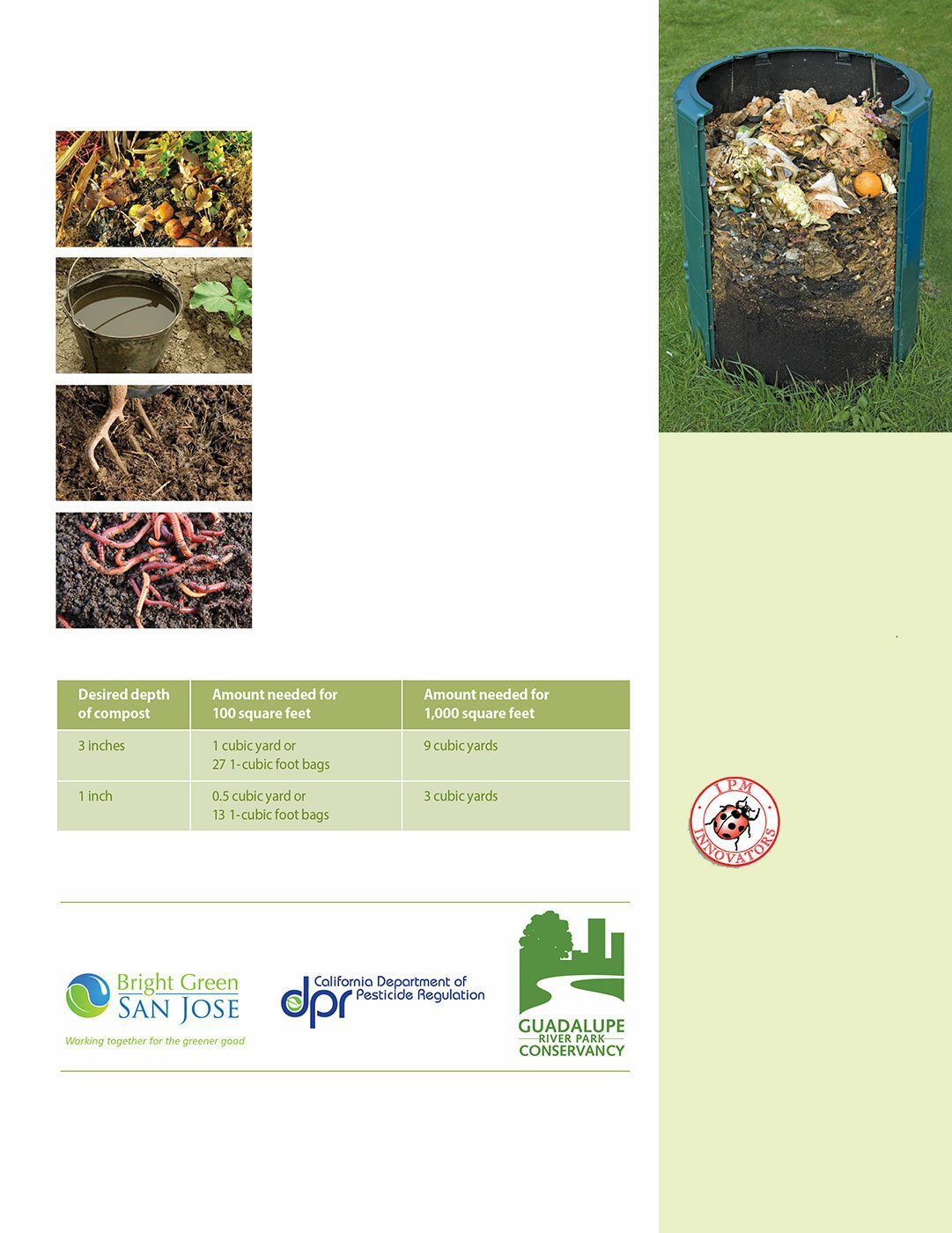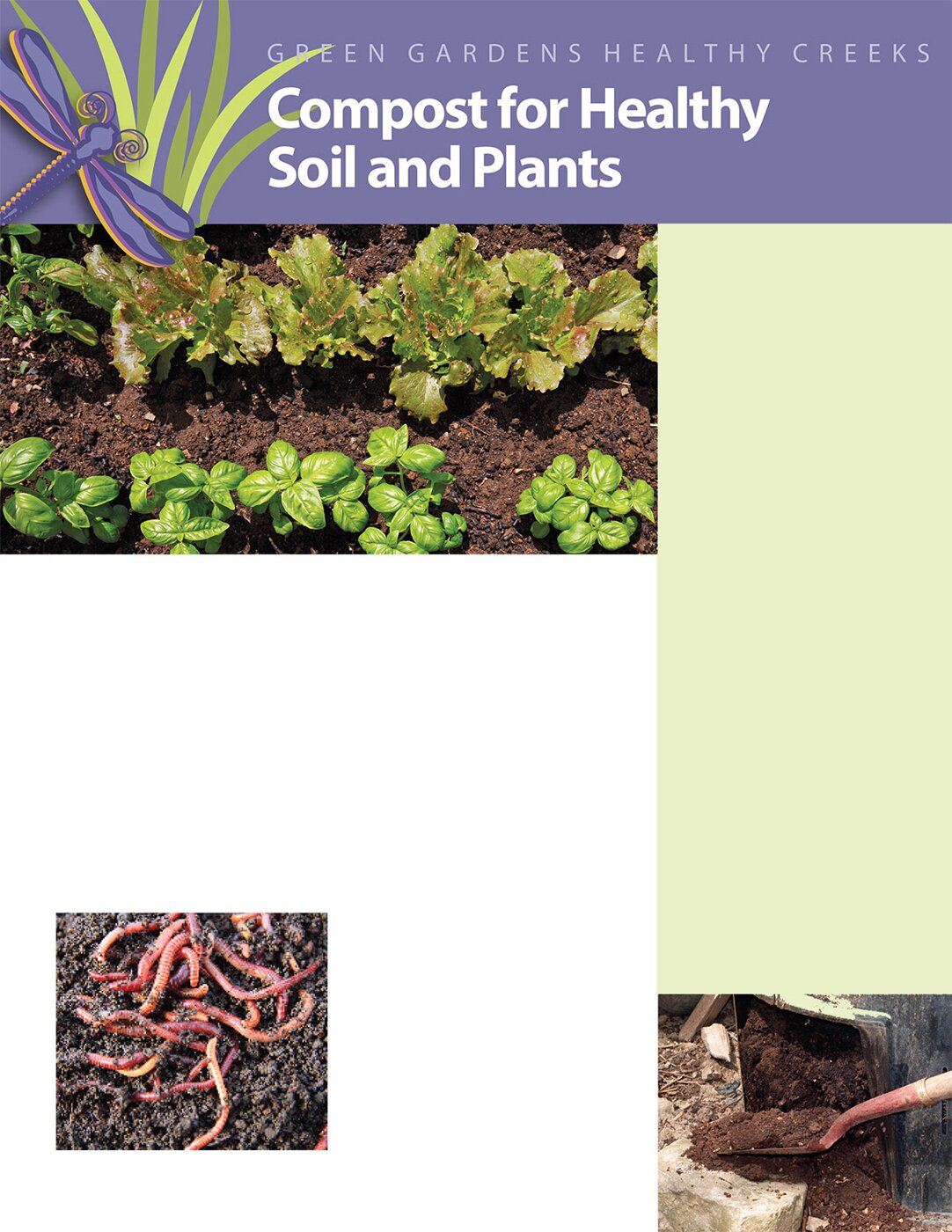two to three inches of compost. In clay soils, compost will improve aeration and drainage. In sandy soils, a generous application of compost will help retain soil moisture and nutrients.
For existing garden beds or loamy soils, mix one inch of compost into the root zone to promote beneficial microorganisms and maintain good soil structure. Apply coarsely screened compost around annual vegetables or flowers to help conserve moisture and suppress weeds.
For lawns, apply a 1/2 - inch layer of finely screened compost (1/4 - inch to 3/8 - inch screen) to the lawn surface. This will provide nutrients, improve water retention, and along with aeration — protect against compaction. Compost also helps the soil decompose grass clippings. The best time to apply compost is in the spring or fall, before or after aerating the lawn. For more information, see the UC Guide to Healthy Lawns.
To understand your soil type, see the Start with Healthy Soils factsheet in this series.
In nature, leaves and twigs fall to the ground and become compost as they decompose. This compost is alive with beneficial microorganisms that break down organic matter into nutrients that are essential for healthy plants. You can establish this healthy process in your own yard by using compost.
Using Compost in Your Sustainable Landscape
When planting trees and shrubs, blend a 1:3 ratio of compost and excavated soil into the planting hole. If already planted, amend the areas surrounding trees and shrubs with
Rich compost with worms and/or insects.
Compost Benefits
Compost can provide long-term benefits for your landscaping investment. Specifically, composting:
- Feeds soil life
- Improves soil structure and permeability
- Improves drainage and moisture retention
- Reduces the need for fertilizers by storing nutrients for gradual release
- Helps conserve water by increasing moisture retention
- May help control soil-borne plant diseases
- Can bind and degrade some pollutants.
Is Compost a Fertilizer?
While both compost and fertilizers provide plants with nutrients, there is an important difference. Compost feeds the soil food web so that plants can feed themselves. Compost is therefore not considered a fertilizer because it has very low levels of readily-available nutrients. Fertilizers feed plants directly and should be used only when conditions require it. For more information about how and when to use fertilizers, see the Fertilize Responsibly factsheet in this series.

Types of Compost
There are several ways that compost can be made, either at home, or commercially for purchase:
Compost Pile – A compost pile is a pile of organic material that is decomposing into usable compost. Piles do best when located in a sunny spot (at least a half-day of sun) with good drainage and provided a balance of carbon-rich yard trimmings and nitrogen-rich food waste.
Compost Tea – Compost tea is made by steeping compost in water (first aerating the water to eliminate any chlorine, which can kill beneficial organisms). Immediately after steeping, the tea is sprayed on soil and leaf surfaces. As a leaf spray, the tea may help prevent certain plant diseases.
Manure Compost – Composted manure is ideal for spreading over a large area. When properly produced and applied, it can kill pathogens and weed seeds while increasing water retention in the soil.
Worm Compost (vermicompost) – Worm compost or vermicompost, is rich in beneficial worm castings, and ideal for small gardens. At home, the typical approach to producing vermicompost is to feed food scraps to worms kept in a worm bin.
Developed by Ecology Action of Santa Cruz consulting with the City of San José IPM Program, 408-945-3000. Content reviewed by A. Sutherland, Urban IPM Advisor Alameda County, UC Statewide IPM Program.
Funding for this project has been provided in full or in part through a grant awarded by the Department of Pesticide Regulation (DPR). The contents of this document do not necessarily reflect the views and policies of the Department of Pesticide Regulation, nor does mention of trade names or commercial products constitute endorsement or recommendation for use.
For more information about sustainable gardening, please visit www.bayareaecogardens.org
Cross section of a compost bin.
Make your own compost
You can make compost using vegetable scraps and/or garden trimmings. Refer to the The County of Santa Clara Home Composting Education Program website for information and resources.
City of San José:
the IPM Innovator
Award Winner 2010
Additional Resources
Helpful Website:
Master Gardeners of Santa Clara County
Factsheets:
To learn more about compost, plant choices, or other sustainable principles, see the other factsheets in this series at www.sanjoseca.gov/environment.
